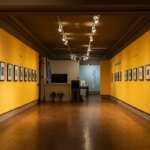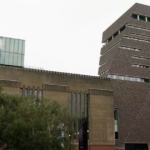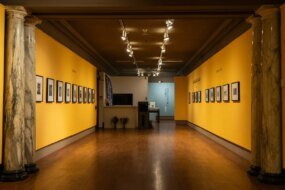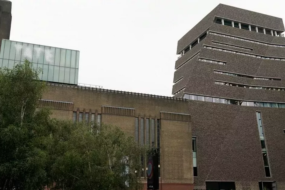

(Credits: Far Out / Coco Fusco / Guillermo Gómez-Peña)
Ah, the art world is so serious and so stuck up sometimes. It’s a world of contradictions. Art is so often so progressive; it prides itself on that. But, in contrast, the actual art industry, the world of galleries and finances, can be quite the opposite, filled with problematic figures and choices and a long history of injustices. However, it can’t function without the artists themselves, giving creatives the upper hand. That’s always fun to play with, and when Coco Fusco and Paula Heredia launched The Couple In The Cage, they pulled off an incredible point-and-laugh prank on the art industry and civilians alike.
In 1992, this fascinating exhibition-slash-experience began touring. I saw the exhibition because it was something to come and look at. It was a spectacle that sometimes appeared in galleries but then sometimes simply appeared in town centres as it moved around the world. It went everywhere from Europe to America, Australia, and beyond, and interest in it never ceased because what was on display was so fascinating.
It was two people – brand new people from a brand new population – from Guatinau, a far-off land. To show these new people to the world, they were being taken around it in a cage. The onlookers flocked in simply to watch the man and the woman interact, watch the TV they’d been gifted, or just exist. The crowd could pay them to do tricks like dance or tell a story in their native language. They could pay for a photo too, enjoying the thrill of getting right up to the bars and maybe even being touched by them!
How would it make you feel? Would it be disturbing to walk into a gallery, an event, or into town and see two people in a cage? Dressed in strange clothes from their native land, they were unlike anything anyone had ever seen. They were fascinating and freakish – but is it right to stare? To some, it wasn’t. Each stop of the tour was met by that contrast as some of the crowd wowed over the caged people, and others sobbed or screamed or called up the gallery that was hosting them to complain. Some even called the authorities to report the event, claiming it was slavery or cruelty.
But you know, they seemed happy enough. The cage people seemed fine, so should the crowd have cared? They were paid and well looked after, and they were seeing the world in a way their homeland and origins wouldn’t have been able to afford them without this opportunity. Sure, they were exploiting themselves, offering themselves up as things to be gawked at, but is that not fine when they have done the offering?
Those were all the burning questions, and that was the point. While all these galleries and venues hosted the event, and all the onlookers paid to come see it, thinking they were staring at real-life inhabitants of Guatinau, they weren’t. They were staring at Coco Fusco and Paula Heredia, two performance artists from Cuba and Mexico. Guatinau does not exist.
The whole thing was an elaborate worldwide prank on the art industry and its onlookers. Captured in a documentary filming the whole rouse, you see Fusco, Heredia and their helpers having private giggles about what they were pulling off, smirking from behind the bars. But you also see them disgusted at what was unfolding, knowing that their prank was real elsewhere and had been historically real.
The whole concept was inspired by the history of sideshows and the dark connection to ethnological exhibitions that especially impacted stereotypes surrounding people of colour. In the film, clips of these historical spectacles, seeing crowds staring at people with physical deformities or differences, or people from different countries, are cut in between clips of the artists’ prank, drawing a sickening line between these crowds in the 1990s being willing to pay a caged person to dance and a dark history humanity thought we’d perhaps moved on from.
In the end, the tables were turned as Fusco and Heredia, in costume, walked their white, American helpers out of the exhibition area on leashes, shocking the onlookers back to reality. But for Fusco, it never really ended. She told MOMA, “The performance and its repercussions completely changed my life. In a way, I will always be the girl in the cage,” sharing the impact this prank had on her, being just as poignant as to those fooled and then confronted by it.
Related Topics









